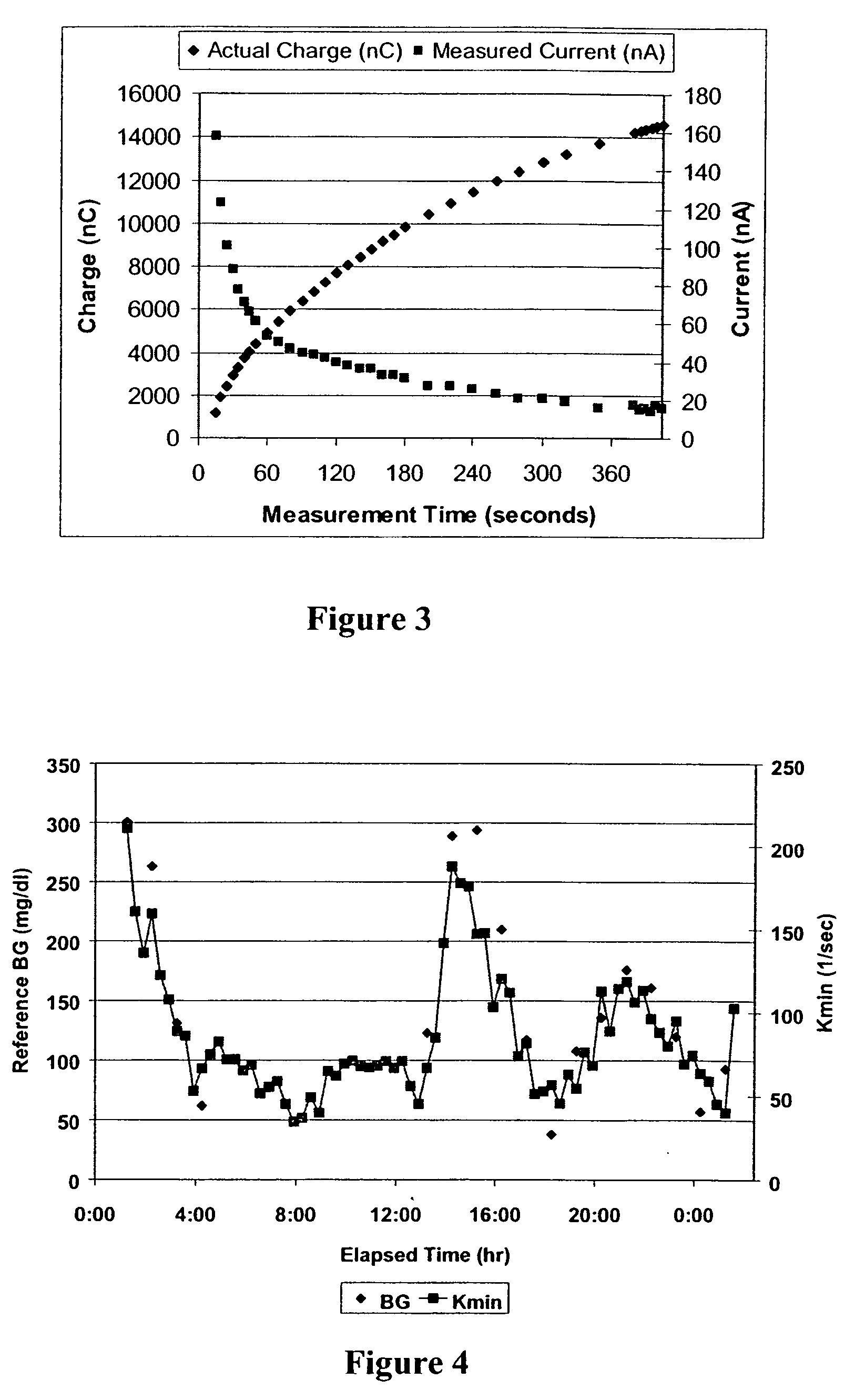Micropressors, devices and methods for use in analyte monitoring systems
a micropressor and monitoring system technology, applied in the direction of instruments, material electrochemical variables, diagnostic recording/measuring, etc., can solve the problems of reducing the accuracy of enzyme reaction-based biosensor data, reducing the sensitivity of conventional kinetic methods, and reducing the accuracy of conventional methods. , to achieve the effect of improving accuracy, reducing lag times, and extending usability
- Summary
- Abstract
- Description
- Claims
- Application Information
AI Technical Summary
Benefits of technology
Problems solved by technology
Method used
Image
Examples
example 1
Discussion of the PK and 7-Minutes Integration Methods
[0329] Data were collected using GlucoWatch biographers on human subjects. The electrode response to the glucose was monitored. The current responses were then transferred to a computer for data processing. The subjects were monitored for approximately 26 hours. Briefly, samples comprising glucose were transdermally extracted from the subject using a GlucoWatch biographer in operative contact with a skin surface of each subject. Measured current signals were obtained over time. The measured current signals comprised a measured current signal response current curve, from the extracted glucose, wherein the measured current signal is specifically related to the amount of glucose in a hydrogel of a GlucoWatch biographer. After integration, a measured charge signal over time was obtained. The measured charge signal comprised a measured charge signal response curve that was specifically related to the amount (or concentration) of gluc...
example 2
The 1 / k2 Effect
[0335] A typical example of the 1 / k2 effect is shown in FIG. 16(b). In this example, the charge signal was calculated using the 7-minute fixed-point method (FIG. 16, panel a) and 1 / k2 calculated from the 3-min data fit to the PK Eq. (3A) (FIG. 16, panel b), as follows: Q(t)=S0+c1k1(1-e-k1t)+c2k2(1-e-k2t)(Eq. 3A)
[0336] The fixed point-method values and the 1 / k2 values were plotted together with the reference BG as functions of the elapsed time (ET). Both 7-minute charge signal and the 1 / k2 signal had been converted into glucose readings using simple single-point calibration at 1 hour ET. An exemplary calculation of glucose concentration based on charge signal is as follows: [Glu]t=[Glu]calnCcal(nC(from 7 min signal)):[0337] where Glut is the glucose concentration at time t, Glucal is the glucose concentration at the time of calibration that corresponds to nCcal, the nC charge (integral of current) at the time of calibration, and (nC 7 min signal), is t...
example 3
Analysis of the Correlation of Kmin and Kratio to Analyte Amount or Concentration
[0344] In order to confirm the obvious visual observations exemplified in FIG. 16 in a more quantitative way, the data from 119 GlucoWatch biographers was analyzed.
[0345] Both Kmin and Kratio analyses were performed on data sets from 119 GlucoWatch biographers that had been applied to human subjects. The same execution steps were followed to calculate {c1, c2, k1, and k2} values for each cathode cycle. Then Kmin and Kratio analysis were calculated and paired with reference BG values.
[0346] Because each estimate (i.e., fitted parameter) had different units, a one point calibration was done at Elapsed Time (ET) 1:14 (or first available reference BG) and estimated glucose values were converted into same unit (mg / dl). The parameters c1, c2, k1, and k2 were estimated using the following equation fitted to the first three minutes of signal charge data at each time point: Q(t)=S0+c1k1(1-e-k1t)+c2k2(1-e...
PUM
| Property | Measurement | Unit |
|---|---|---|
| time | aaaaa | aaaaa |
| monitoring time | aaaaa | aaaaa |
| current | aaaaa | aaaaa |
Abstract
Description
Claims
Application Information
 Login to View More
Login to View More - R&D
- Intellectual Property
- Life Sciences
- Materials
- Tech Scout
- Unparalleled Data Quality
- Higher Quality Content
- 60% Fewer Hallucinations
Browse by: Latest US Patents, China's latest patents, Technical Efficacy Thesaurus, Application Domain, Technology Topic, Popular Technical Reports.
© 2025 PatSnap. All rights reserved.Legal|Privacy policy|Modern Slavery Act Transparency Statement|Sitemap|About US| Contact US: help@patsnap.com



